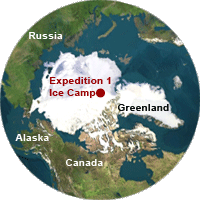The North Pole Observatory Expedition: April 18-28, 2007
Introduction
The first adventure begins during the International Polar Year, when the Polar Discovery team will document scientists working at an ice camp at the North Pole. Through daily stories, photos, and videos, Polar Discovery will give you an inside look as researchers battle temperatures plunging to 30 below zero to take the pulse of the climate at the top of the world.
Base Camp
Every April since 2000, an international research team led by the University of Washington Polar Science Center has conducted expeditions to the North Pole to take the pulse of the Arctic Ocean and learn how the world's northernmost sea helps regulate global climate.
The science team establishes a base camp, called the North Pole Environmental Observatory (NPEO), at the privately operated Russian/French ice camp Borneo, a temporary cluster of tents erected at 89 degrees North. Borneo has been accommodating tourists, explorers, and scientists since 1993. The camp operators smooth out a 3000 foot long runway so that ski-equipped planes can land right on the sea ice. Two large Russian helicopters ferry tourists to the Pole and scientists to their remote camps.
Science Projects

The University of Washington coordinates the diverse NPEO research team. In addition to making a core set of instruments to track Arctic Ocean changes, NPEO aims to distribute the core data as widely as possible to the rest of the science community and to provide operational support and background data to other investigators. This year, scientists from the following institutions will be working on the ice:
- University of Washington Polar Science Center (UW-PSC), Seattle, Washington
- Oregon State University (OSU), Corvallis, Oregon
- Naval Postgraduate School (NPS), Monterey, California
- National Oceanographic and Atmospheric Administration's Pacific Marine Environmental Laboratory (NOAA-PMEL), Seattle, Washington
- U.S. Army Cold Regions Research and Engineering Laboratory (CRREL), Hanover, New Hampshire
- Japanese Marine Science and Technology Center (JAMSTEC), Yokosuka City, Japan
- Woods Hole Oceanographic Institution (WHOI), Woods Hole, Massachusetts
Live from the Poles Coverage
In April 2007, the Live from the Poles media team will travel to the Borneo ice camp to document the following projects:
- Engineers from the University of Washington will retrieve and redeploy a 2.6 mile-long moored chain of instruments. This mooring has been in operation since 2000, providing a long-term look at how arctic waters are responding to climate change.
- Scientists from the University of Washington and Oregon State University will conduct an air-based survey of the surrounding waters. These snapshot measurements include the physical properties and chemistry of arctic seawater.
- The Woods Hole Oceanographic Institution will be joining NPEO investigators from JAMSTEC, PMEL, CRREL, and the Naval Postgraduate School in establishing the 2007 NPEO Automated Drifting Station. This station, centered at Borneo but with several far-flung satellite stations, provides the kind of data that used to only be provided by manned drifting stations.
The North Pole Environmental Observatory is supported by the National Science Foundation (NSF).


